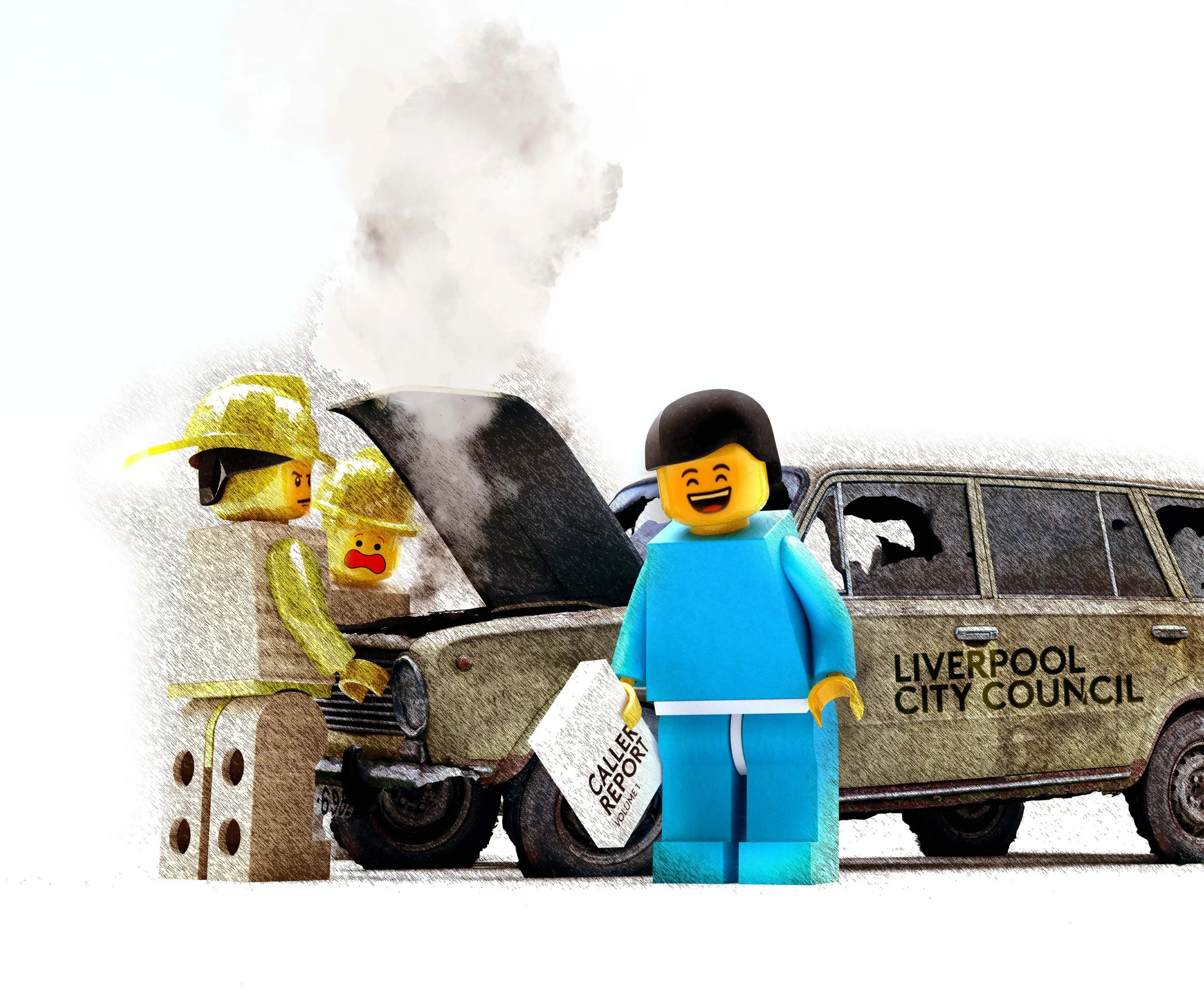Recent features
Introducing the Assembly District
History teaches us that no matter which party is in power in Westminster, only the north can be trusted to look after the north. But it should also teach us that the politics of agglomeration are divisive and will not end well for anyone but Manchester and Leeds. But never fear, Michael McDonough offers a solution - tearing up our current constitutional arrangements and establishing a new Northern Assembly for all of the north located on the banks of the Mersey. And he’s only gone and designed it … welcome to Liverpool’s new Assembly District.
Michael McDonough
Quite how Manchester Metro Mayor, Andy Burnham came by his coronation in the media as ‘King of the North’ is subject to conjecture.
Some such as journalist and author Brian Gloom speculate that it started as an internet meme, while others wonder whether it was a creation of Marketing Manchester, an agency never shy to position it’s home city as the centre of everything. Whatever its source, and Burnham has himself joked about ruling from a Game of Thrones-style castle, like all good observation comedy, its absurdity is centred on a degree of truth. You’d have to have been operating with your eyes closed since at least the emergence of David Cameron’s government in 2010, not to pick up the sense that Manchester has become the increasingly less unofficial capital of the north, much favoured by business, government ministers and media alike. It’s hard not to notice that whenever the north’s regional mayors get together for a photo op or conference, it’s Burnham that is usually centred as the pivot point around whom others orbit.
You could say this position is much deserved. Over several decades Manchester has played a very successful and canny game and has done much in the running of its economy that is both admirable and instructive to other regions with ambitions to raise their own performance. But this article is not intended as a Manchester love-in. The fear from the outside is that other regions, most notably its closest neighbour Liverpool, are caught in something of a gravity well, heading towards the event horizon, where the blackhole sucking in wealth and talent becomes inescapable.
The UK government appears to have been operating a policy known as agglomeration where the economies of towns increasingly centralise around cities, and the economies of cities are pulled towards the biggest and best of them. The idea is that a northern London will offer snowball effects that drive increasing productivity and opportunity. Any attempt to discuss the downsides are quickly dismissed as jealousy. But what happens to everywhere else? As any real political or investment efforts become increasingly centred on Manchester and Leeds, the north’s other towns and cities are forced to focus on more tertiary and lower value economic sectors to avoid this very obvious elephant in the room. No wonder there’s much discussion about transport. You need good trains and good roads to create a commuter belt.
Whether the north actually needs a ‘King’ is moot, it seems to be getting one, whether it likes it or not. In which case, maybe that King (or future Queen) really does need a castle or administrative centre from which to watch over their lands.
I’m being facetious, of course. But there is one idea that’s been doing the rounds for decades about the governance of the north that never truly goes away, even if no one has quite had the courage to turn it into reality. I’m talking about a Northern Regional Assembly or Parliament – a new constitutional arrangement that would put meat on the bones of devolution. I think it’s worth considering, for two reasons. Firstly, because history teaches us that no matter which party is in power in Westminster, nothing really changes for us. A Northern Regional Assembly would be founded on the simple understanding that only the north can be trusted to look after the north. And the second reason is that, done right, an Assembly could help to counter the divisive politics of regional capitals and agglomeration economics. Power could be distributed in a way that lifts up many communities, rather than few. For this reason an assembly must never be located in Manchester.
‘Let’s aim high. Consign talk of the ‘King of the North’ to the metaphorical dustbin and carve out a new sense of identity and purpose.’
I’ll leave the finer details to minds more attuned to the vagaries of politics and taxation, but it would almost certainly require a bonfire was made of existing local governance arrangements. This would not be yet another fatty layer of bureaucracy feeding off the twitching corpse of local democracy. It would be the pinnacle of a fundamental re-working of power – a place where the core cities and towns of the north would come together to fix and finance their priorities at scale. Cities like Liverpool, Manchester, Sheffield and Newcastle joining forces with the Hull’s, Sunderland’s, Blackpool’s and York’s with one objective in mind – to challenge the economic pull of London and re-position the north as the economic engine room of the UK.
Maybe that sounds fanciful. Can we really reverse the economic gravity of the last 150 years? I don’t know the answer to that but I’d sure like to try. We should have some confidence about what is possible. Most of the UKs core cities reside in the north and our economy is bigger than that of whole countries such as Belgium, Denmark, Ireland, Portugal and Sweden. Our population is made up of 15 million souls and we account for about 20% of the UKs national GDP. While Westminster neglects to address the wealth inequalities that fuelled the demands for Brexit, isn’t it time we took power into our own hands and gave our region a stronger, collective voice? One where different parts of the north were incentivised to put aside regional rivalries and work together.
In which case, I’m going to ask you to imagine a world in which Liverpool becomes the focal point and home of that Northern Assembly. Is that really so far-fetched an idea? Some would immediately dismiss the prospect. Our council is after all essentially under special measures being guided towards competence by government appointed commissioners because we couldn’t manage it ourselves. What credentials do we have? But I’d simply say, why not? We may have had a politically turbulent history and a less than stunning present, but we also have a tradition in the last one hundred years of standing up for the many, not the few. Perhaps there is no more natural home for a regional assembly based on pan-northern equality and fairness as opposed to agglomeration, soft power and resource thirsty regional capitals.
Besides, despite all its issues, Liverpool is a city with an enviable international draw, incredible setting and bags of waterfront space to house such an assembly. A parliament might actually give Liverpool Waters some actual purpose too, while raising our own city’s aspirations. Some of our own will decry it as pie in the sky. But let’s not throw rocks or weave excuses. Let’s aim high. Consign talk of the ‘King of the North’ to the metaphorical dustbin and carve out a new sense of identity and purpose. One that is not only forward looking and aspirational but is also collaborative with its neighbours and based on a desire to see balance, fairness and justice intertwined into the north’s wider politics. it’s already there in the minds and hearts of northern people. Now let’s put it there in the institutions that represent us.
And so in the rest of this article, I’ve taken the liberty of going ahead and designing it. I hope you don’t mind the presumption but they do say a picture is worth a thousand words. I’ve created a series of visuals to conceptualise a new government district centered on Liverpool’s Central Docks.
Assembly District - Principles and Functions
Assembly District fly through.
Today, the site is owned by Peel Holdings and development plans are proceeding at a snail’s pace. A recent consultation was announced for some kind of canalside park, but it’s a blank canvass and no buildings have been announced. The creation of a new political ‘village’ or district laid out to intertwine with neighbouring developments such as Stanley Dock and Ten Streets could be the final piece of the jigsaw for Liverpool’s waterfront regeneration.
This new district would have to accord with some key functional imperatives and some core design principles. For function, the area must be able to accommodate our representatives and supporting administrative staff comfortably and securely. It must capitalise on the economic opportunity by creating desirable workspace which will be attractive to inward investment, and it must be broadly open to the general public to enjoy offering new facilities which are available to all.
From a design perspective, the development should be ambitious and contemporary, forward-looking, sustainable and transparent. This area should boast a ‘postcard design’ while being the embodiment of openness to enshrine in the built form the idea that our representatives work for us, not themselves or even their parties. A trigger for the designs should be northern solidarity. In addition, I’d like to create an element of pleasure through the creation of quality, yet surprising recreational space.
The Plan
Conceptually, the Central Docks plot would be divided into two areas: river and canal side to the west and further inland to the east. The waterside plots would feature the landmark structures and open space, while the east side could house complimentary mixed-use facilities including both work and residential schemes. Mirroring the adjacent Ten Streets grid pattern, the plans would see a series of new tightly packed, pedestrianised streets opening up the Central Docks site before reaching a series of new waterways and ‘blue spaces’ which will be reclaimed from parts of the site that are currently infilled docks.
New architecture on the site will be encouraged to straddle our quaysides, complimenting and working with water space rather than requiring for it to be filled in to create room for building. This in meant as both a symbolic and practical gesture of compromise in a city often at loggerheads with itself on how to reach for the stars architecturally without compromising existing heritage.
The centre piece of this new district would be the Northern Assembly building. Built across a series of pillars and positioned across the quayside to create a floating form, the building would be in a perfect position for security being largely surrounded by water and accessed only from one side. As a landmark for the north of England, the assembly would feature a circular internal layout to encourage parliamentarians to work together as one collective, while ensuring all areas of the north where represented equally. Cladded in steel and glass, with an undulating façade, the building would take some inspiration from Germany’s Reichstag building in which the public are free to observe parliamentary sessions as part of a commitment to transparency.
On the riverside of the Assembly building, a new public space would be built on a series of interconnected concrete pier structures inspired by Heatherwick Studio’s ground-breaking and beautiful Little Island Park in New York. Each of the up to 50 piers would represent core towns and cities as part of a linear park space on the water’s edge topped with attractive landscaping and robust Mersey-friendly planting. The piers are also symbolic of Liverpool’s position as an arrival and departure point for the whole of the north of England. Together with green spaces throughout the site, reclaimed and newly created blue space and interconnecting bridges this area would become a landmark open space for the city, a riverside space to think, debate, contemplate and engage with politics in a new heart of central Liverpool.
Two other landmark buildings neighbouring the Assembly are proposed for the water-side plot – one striking, multi-use cultural building and one mixed use 35-storey office and hotel.
The office and hotel building has been given a classic robot form with square body, head and antennae – this slightly retro but nevertheless futuristic form pointing to the need to put the industries of tomorrow at the heart of the north's strategy.
The form of the cultural building, which could house museums, exhibitions, performance and meeting spaces as well as a visitors centre, is modelled on a modern interpretation of Liverpool’s Anglican cathedral while it’s four brick turrets are an echo of the city’s landmark Liver Building. The overall effect is somewhat church-like to reflect the central role that faith and secular belief and moral values have in our communities and their deep historical roots in the region.
Transport
One of the key issues facing Liverpool’s central and north docks area is that of connectivity. To compare Central Docks to waterside redevelopment plots in London’s Battersea and Docklands areas it’s clear that a development of this scale and footfall would require a comprehensive transport strategy.
Conceptual design for Ten Streets station, Northern Line.
One possible solution would be the development of a station on the Merseyrail Northern Line to the western edge of the site. Built across existing railway viaducts and positioned equidistant between Moorfields and Sandhills. This new station could multiple audiences including the emerging creative Ten Streets district, Assembly District and also Everton’s Bramley Moore Stadium a few hundred yards north.
One of the key factors slowing down the regeneration of the north Liverpool docks has been access to the city centre and transport in general. Whilst a station at Ten Streets would go a long way to addressing this problem, the influx of new high density development may increase the viability of further transport infrastructure. The plans to the east of Central Docks envisage a concentration of high density homes and commercial and administrative buildings. The substantially increased footfall and employment in the area could support the creation of a new light rail link connecting directly with Lime St station through the currently disused Waterloo/Victoria tunnel alignment.
For illustrative purposes and to create a sense of arrival at the new Ten Streets station, I am proposing two wing-like structures addressing a new public square. Essentially abstract in form, they provide a modern interpretation of the industrial cranes that would once have been seen in the area. They also serve an important function, providing weather-proof covering for 4 escalators which take passengers up to the station’s platform level.
The Northern Assembly is the first of a two part article exploring the development of the Central Docks area. For our next article I will be exploring how the Ten Streets district itself could take advantage of Liverpool’s digital and gaming sector and if extended pull the area closer to the city centre.
Michael McDonough is the Art Director and Co-Founder of Liverpolitan. He is also a lead creative specialising in 3D and animation, film and conceptual spatial design.
Share this article
What do you think? Let us know.
Write a letter for our Short Reads section, join the debate via Twitter or Facebook or just drop us a line at team@liverpolitan.co.uk
A new central Liverpool
As a youngster I’d often be dragged kicking and screaming into ‘town’ by my mother, first from Aigburth and later Speke on the 82 bus for a day traipsing around central Liverpool. The delights of these trips would include Solitaire, Dodo’s and Miss Selfridges (all high street names now consigned to the past) and we would start this bonanza at Lewis’ department store, jumping off the bus and into the throng of Saturday morning shoppers. We’d cut through Lewis’ giant store before heading to what was then the newly opened Clayton Square shopping centre and a supposedly refreshed green-glass clad St Johns Centre. From there the misery of shopping with your mum on a Saturday would commence.
Michael McDonough
As a youngster I’d often be dragged kicking and screaming into ‘town’ by my mother, first from Aigburth and later Speke on the 82 bus for a day traipsing around central Liverpool.
The delights of these trips would include Solitaire, Dodo’s and Miss Selfridges (all high street names now consigned to the past) and we would start this bonanza at Lewis’ department store, jumping off the bus and into the throng of Saturday morning shoppers. We’d cut through Lewis’ giant store before heading to what was then the newly opened Clayton Square shopping centre and a supposedly refreshed green-glass clad St Johns Centre. From there the misery of shopping with your mum on a Saturday would commence.
For me it was my first introduction to a big city centre alongside the odd jaunt over to Manchester and it was where I began to really think about architecture and the built environment. I’d see the different building styles and the variety of scale and begin to understand what fundamentally makes a city centre feel vibrant and appealing. Of course, today I’m a bit more travelled but I still think central Liverpool retains a bizarre and unique mix of architecture and energy that few European cities can rival.
Sadly today, Liverpool’s optimistic 1960’s shopping centre architecture and MDF pre-fab station retail (Liverpool Central) is all looking incredibly tired, like a patched up old car that’s had multiple uncaring owners. It still functions but it doesn’t look too good aesthetically.
Let’s take St Johns Centre, the largest indoor shopping centre in the city, squatting as it does right next to Liverpool’s front door to the world - Lime St. It’s also directly adjacent to some of the world’s finest neo-classical architecture such as St Georges Hall. This shopping behemoth, designed by architect James A. Roberts, landed ungraciously on the city in 1969 and has suffered two fires and several re-clads, leaving us with a mish mash of hasty spruce-up’s from owners who have lacked the deep pockets to do anything truly worthwhile.
The Centre itself was actually a much smarter affair when it first opened, before it was mauled by those who, in the 1990’s, thought faux-Victorian brick features would add a dash of sophistication. Still, in its defence St Johns remains very profitable for it’s owners, and this is likely the reason why it continues to squat on what should be a prime city centre site - a pound shop paradise instead of a Gucci-style emporium. It’s not all bad though, we were also gifted St Johns Beacon in 1969 as a glorified chimney to ventilate the centre. Better known today as the Radio City Tower, it’s become a landmark in itself, but also architectural marmite. Shorter than was originally intended, it’s short-lived rotating restaurant feature has long-since closed with its crown now defaced with radio antennae. Recently it was threatened with a quite frankly ridiculous zip wire proposal that would have seen the more adventurous amongst us flung across St Georges Hall before landing on top of the Liverpool Central Library, but thankfully, the subsequent uproar consigned the scheme to Liverpool City Council’s rather large book of planning mistakes.
St Johns Centre as viewed from St Georges Hall, 2020.
Clayton Square (left) and St Johns Centre (right), 2020.
St Johns is sadly not alone across this axis of tat that defaces central Liverpool. There is also the now, in my view, ruined Clayton Square. You might notice that I don’t refer to it as a ‘shopping centre’ because today it is a far cry from its intended design, having been boxed up internally for long standing retail anchor Boots the Chemist. The original grand and spacious feel of the 1990’s glass-covered mall lost behind MDF wall panels. The only redeeming feature of Clayton Square is its distinctive glass dome as a reminder of what once was. Again, the victim of a visionless ownership doing the bare minimum, this once impressive shopping centre has been turned into a forgettable cut-through.
Sadly today, Liverpool’s optimistic 1960’s shopping centre architecture and MDF pre-fab station retail (Liverpool Central) is all looking incredibly tired,…
The rap sheet of poor developments goes on…there’s the now wrecked former Blacklers store populated at ground level by the Wetherspoons pub chain and greasy low-end fast food joints. The unforgivebly bland and beige ION student accomodation scheme which replaced the Futurist (a building that still needed to go as it was collapsing). Its depressing cladded hulk hiding the even more depressing breeze block, creaking floor misery that is the Student ‘Castle’ behind. Then there’s the decaying former ABC art deco cinema on the opposite side of the road that has also fallen victim to numerous false dawns including plans to turn it into a TV studio. And who could forget the Holiday Inn towering above St Johns? For some bizarre reason, the hotel was painted black with white window frames and now provides a nice clean target for seagulls offloading their mess quite visibly across the facade, a delight I’m sure for those arriving at Lime St for the first time. But the pièce de resistance has to be the blue plastic cover stretching around the St Johns Centre car park as an apologetic gesture from the city leaders, who are all too aware of how much of an embarrassing eyesore this part of the city has become. No amount of repaving is going to fix that one.
I should stop there as the horrors of Williamson and Queens Squares with their out of town retail architecture are too much to bare. Even the entrance to Liverpool Central station and shopping centre is a sorry indictment of how quick the city is to demolish great architecture and replace it with worse. Too little is invested in Liverpool’s transport infrastructure today. If this was London, things would look very different.
Anyway, that’s enough of the critical; let’s move on to the constructive! At Liverpolitan, when it comes to architecture and urban design we at least like to have a stab at putting our money where our mouth is and so we’ve visualised what central Liverpool could potentially look like with a major, joined up and comprehensive redevelopment plan akin to Liverpool One.
The featured visuals explore how a forward-thinking city administration, alongside some ambitious local politicians and business leaders might take central Liverpool forward. The designs imagine a city centre unlocked from the obstructive mess that indoor shopping centres have created and moves instead to individual buildings and re-instated streets. Those buildings play host, not to the bargain basement, but to hotels, much needed Grade A flexible office and event spaces, small and medium-sized businesses. There’s also a leisure and media hub, landmark building to replace Clayton Square and ground-level, accessible market space to replace St Johns Market, now relocated to Williamson Square with the potential for it to spill out into the surrounding streets.
We imagine a new central Liverpool anchored by a new transport hub with a major expansion of Liverpool Central station returning this increasingly overcrowded and underinvested underground station in to something more in line with its former role as a national gateway with the completion of the Edge Hill Spur scheme to tunnel the Northern line out to Edge Hill and beyond (we’ll have an article on that at some point).
New and re-instated street connections between Queens Square and Central Station offer a clear line of sight through to the St Georges Hall portico. Rather than repeat the mistakes of St Johns, which for want of a better phrase, turned its architectural ‘arse’ to one of our grandest buildings, new structures will offer a proud face towards it. It’s almost as if architects in the 1960’s dismissed St Georges Hall as some imperialist soot-covered beast that would soon be demolished, and so contextually didn’t matter. Bulldozers were on the cards for Lime St’s Great Northwestern Hotel frontage, it it wasn’t for a campaign to stop them.
The design concepts envisage a far more porous central Liverpool with a new green space, elevated across several levels, looking out across St Georges Plateau. Hopefully it would act as an invitation to the now sad and disconnected lower London road to join the re-development party and come back into the city centre fold. Scale and world class architectural design would be the order of the day much like Liverpool One. Instead of leaving such an important project in the hands of a clique of local developers practice on a budget, International competitions would invite the world’s best to compete. Let the best designs and those with the best track records win out.
Lewis’, the former Blackers Store and the remaining streets between would all be spurred on to step-up and re-invent themselves. The result? A whole, new beating heart for central Liverpool, far more befitting of where the city wants and needs to be. A statement to anyone arriving at Lime St Station that Liverpool is a world class city that respects its heritage, but is determined to do everything it can to match and surpass its history. One that thinks bigger, and better.
It would be nice to get off the 82 bus one day and walk through a vibrant, modern central Liverpool - a place without chewing gum ridden pavements and hot dog stands. Liverpool One still set’s the bar for city centre regeneration. We did it before, we can do it again.
Michael McDonough is the Art Director and Co-Founder of Liverpolitan. He is also a lead creative specialising in 3D and animation, film and conceptual spatial design.


































